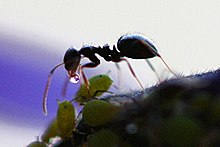**Honeydew Production:**
– Honeydew is a sugar-rich sticky liquid secreted by aphids, scale insects, and other insects as they feed on plant sap.
– It contains sugars, amino acids, organic compounds, and inorganic salts influenced by insect species and host plant.
– Insects like cicadas pierce phloem ducts to access sugar-rich sap, leaving a white sugar crust called manna.
– Ants collect honeydew directly from aphids, benefiting from driving away predators.
– Certain species of birds, mosquitoes, wasps, and bees collect honeydew to process into honey.
**Religion and Mythology:**
– In Norse mythology, honeydew is associated with the ash tree Yggdrasil and bees.
– Greek mythology mentions honey dripping from the Manna-ash, linked to ash tree nymphs and Zeus.
– Honeydew is referenced in Samuel Coleridge’s poem ‘Kubla Khan’ with mythological connotations.
– The Hebrew Bible describes manna, associated with honeydew, provided to the Israelites in the desert after the Exodus.
**Nectar-Producing Trees:**
– Honeydew can be found under certain trees, attracting insects that produce the secretion.
– Different methods of controlling honeydew-producing insects have been studied.
– Trees like the date palm, eucalyptus, oaks, and tamarisk are known for attracting honeydew-producing insects.
– Dense insect populations under trees can have adverse effects, requiring control measures.
**Specific Tree Examples:**
– **Dates:**
– Ommatissus lybicus is attracted to certain cultivars of date palm trees, preferring specific varieties.
– Control methods for these insects, including natural and chemical approaches, have been researched.
– **Eucalyptus:**
– Eucalypt forests see an increase in honeydew nectar and manna production in spring and autumn.
– Various animals are attracted to the nectar produced by eucalyptus trees.
**Ecological Impact:**
– **Flowers:**
– Native bees find insect-produced honeydew sugars before peak bloom, contributing to the ecosystem.
– Honeydew sugars are a valuable energy source for bees.
– **Acorns:**
– Oak honey derived from acorns is a rich source of nutrients with a distinct flavor profile.
– **Insects and Plants:**
– Insects play a vital role in plant evolution, showcasing mutualistic relationships and interconnected adaptations.
Honeydew is a sugar-rich sticky liquid, secreted by aphids, some scale insects, and many other true bugs and some other insects as they feed on plant sap. When their mouthpart penetrates the phloem, the sugary, high-pressure liquid is forced out of the anus of the insects, allowing them to rapidly process the large volume of sap required to extract essential nutrients present at low concentrations. Honeydew is particularly common as a secretion in hemipteran insects and is often the basis for trophobiosis. Some caterpillars of Lycaenidae butterflies and some moths also produce honeydew. In addition to various sugars, honeydew contains small amounts of amino acids, other organic compounds, and inorganic salts with its precise makeup affected by factors such as insect species, host plant species, and whether a symbiotic organism is present.


Honeydew-producing insects, like cicadas, pierce phloem ducts to access the sugar rich sap. The sap continues to bleed after the insects have moved on, leaving a white sugar crust called manna. Ants may collect, or "milk", honeydew directly from aphids and other honeydew producers, which benefit from their presence due to their driving away predators such as lady beetles or parasitic wasps—see Crematogaster peringueyi. Animals and plants in a mutually symbiotic arrangement with ants are called Myrmecophiles.
In Madagascar, some gecko species in the genera Phelsuma and Lygodactylus are known to approach flatid plant-hoppers on tree-trunks from below and induce them to excrete honeydew by head nodding behaviour. The plant-hopper then raises its abdomen and excretes a drop of honeydew almost right onto the snout of the gecko.
Honeydew can cause sooty mold on many ornamental plants. It also contaminates vehicles parked beneath trees, and can then be difficult to remove from glass and bodywork. Honeydew is also secreted by certain fungi, particularly ergot. Honeydew is collected by certain species of birds, mosquitoes, wasps, stingless bees and honey bees, which process it into a dark, strong honey (honeydew honey). This is highly prized in parts of Europe and Asia for its reputed medicinal value. Parachartergus fraternus, a eusocial wasp species, collects honeydew to feed to their growing larvae. Recent research has also documented the use of honeydew by over 40 species of wild, native, mostly solitary bees in California.
